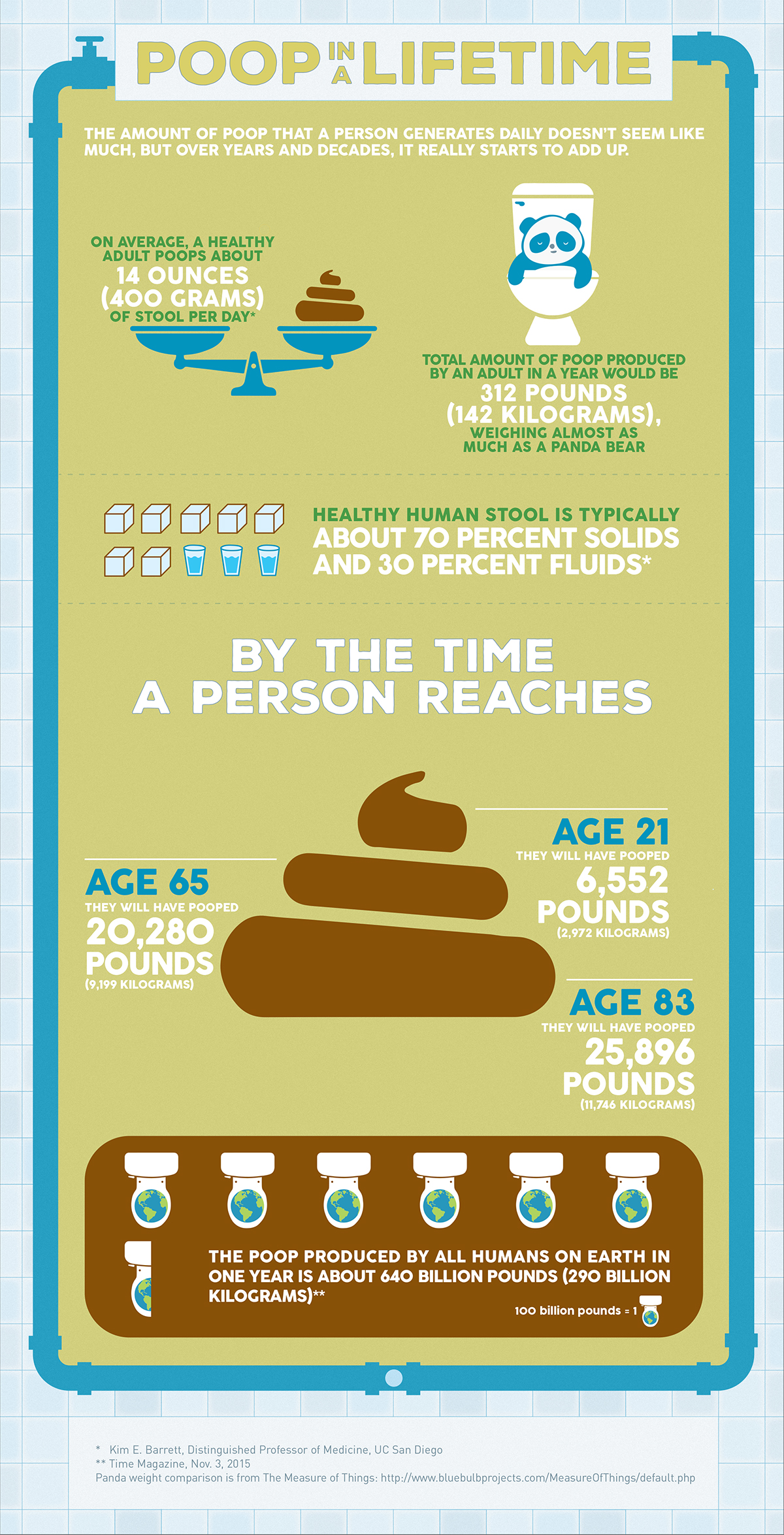How Much Do You Poop in Your Lifetime?

A person's accomplishments accumulate over years and decades. Something else accumulates, too — their poop.
The quantities of poop that people leave behind during an individual bathroom break can vary widely, depending on age, body weight, diet, exercise and other factors.
But how much poop does the average person produce in their lifetime? [The Poop on Pooping: 5 Misconceptions Explained]
- Related: Why is your poop brown?
Moving one's bowels is part of the normal digestive process for most animals; after nutrients are extracted from food and liquid, waste is eliminated as urine and feces. Human stool, when healthy, is usually made up of about 70-percent solids and 30-percent fluids, Kim Barrett, a professor of medicine at the University of California, San Diego, told Live Science. Personal bowel habits notwithstanding, on average, both men and women move their bowels about once per day and produce a daily average of 14 to 17 ounces (400 to 500 grams) of feces, Barrett said.
Researchers have even identified the speed at which humans generally produce their poo: about 0.8 inches (2 centimeters) per second, Live Science previously reported. Constipation — being unable to move one's bowels — can lead to longer, or more uncomfortable bathroom sessions. However, the amount of time a person typically dedicates to unobstructed defecation is about 12 seconds per stool, and is uniform across many animal species regardless of their size, according to David Hu, an associate professor of mechanical engineering and biology at the Georgia Institute of Technology and Patricia Yang, a Georgia Tech doctoral candidate in mechanical engineering.
The amount of poo produced by a single person starts to add up when you calculate poop production over years and decades.
Starting with an average daily amount of about 14 ounces (400 grams), the total poop production in a week's time would be about 6 lbs. (2.8 kilograms). In a year, a single person would yield about 320 lbs. (145 kg) of poop — just a little more than an adult panda weighs.
Get the world’s most fascinating discoveries delivered straight to your inbox.
In the U.S., the average life expectancy for men is about 76 years old, and for women, it is around 81 years old. Therefore, a man living to age 76 would produce about 24,320 lbs. (11,030 kg) of poop over his lifetime, and a woman living to age 81 would produce about 25,920 lbs. (11,757 kg) — so a lifetime of a woman's poop weighs about as much as three adult male hippos.
Recently, the stark reality of how much poop humans can produce prompted action from officials at Denali National Park and Reserve in Alaska. Years of unregulated pooping by visitors to Denali, North America's tallest mountain, left an estimated 152,000 to 215,000 lbs. (69,000 to 98,000 kg) of feces deposited on the mountain between 1951 and 2012.
Another unpleasant reality is that 4.5 billion people around the world do not have access to household toilets that safely dispose of their waste, according to the United Nations. And each year, over 200 million tons (181 million metric tons) of human waste goes untreated, with more than 90 percent of sewage in the developing world released directly into oceans, lakes and rivers.
At least 1.8 billion people worldwide depend on a drinking water source that is contaminated by fecal residue; poor sanitation leads to disease outbreaks and public health crises that affect millions of people each year — many of them children. However, improving access to clean water and implementing better sanitation practices, such as feces containment and treatment that enables its safe disposal, could prevent approximately 842,000 deaths each year, according to reports from the World Health Organization and the United Nations Children's Fund.
Original article on Live Science.

Mindy Weisberger is a science journalist and author of "Rise of the Zombie Bugs: The Surprising Science of Parasitic Mind-Control" (Hopkins Press). She formerly edited for Scholastic and was a channel editor and senior writer for Live Science. She has reported on general science, covering climate change, paleontology, biology and space. Mindy studied film at Columbia University; prior to LS, she produced, wrote and directed media for the American Museum of Natural History in NYC. Her videos about dinosaurs, astrophysics, biodiversity and evolution appear in museums and science centers worldwide, earning awards such as the CINE Golden Eagle and the Communicator Award of Excellence. Her writing has also appeared in Scientific American, The Washington Post, How It Works Magazine and CNN.




